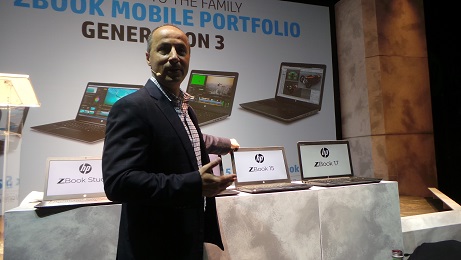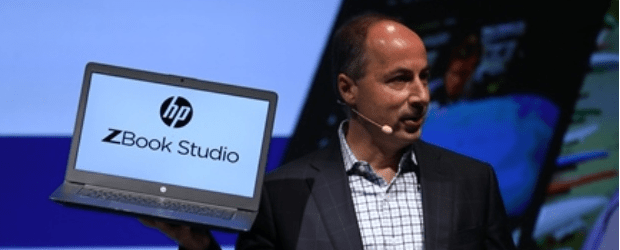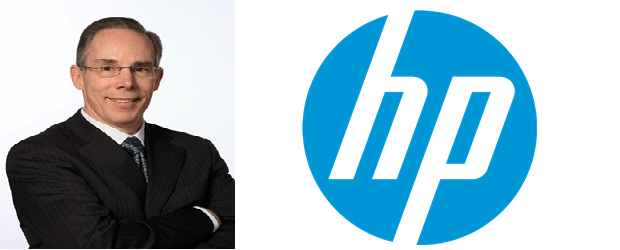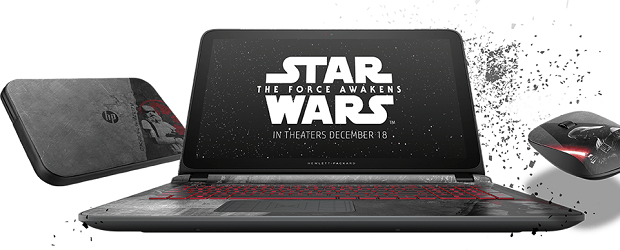NEW YORK – Normally when you look at a workstation capable of developing missiles, making an animation movie or managing the International Space Station it sits on a floor. Just a few weeks after its historic split HP Inc. introduced a new line of four Z Series workstations that no long sit on a floor but are portable and look similar to an ultrabook.
But don’t call it that says Jim Zafarana, vice president, GM and global head of HP Inc. workstations, thin clients and commercial immersive computing, said these new mobile workstations named ZBook are not PCs. “These workstations are not for the faint of heart,” he added.
According to Zafarana, work today is everywhere and workstations need to adapt to the creative professional, someone in outer space and for first responders who’s job it is to save lives.
He added that the new ZBook line are thinner and lighter devices that can handle file sizes for 8-colour film production that is 16 times larger than traditional standard definition movies.
“Workers are now under more intense pressure be it designing a new missile, managing a space station or producing a new movie these are all factors for increased performance,” Zafarana said.
Today, HP Inc. at a special launch event in New York unveiled a first of kind Intel quad core workstation ultrabook named the ZBook Studio. The unit is a 15.6-inch diagonal notebook that Zafarana described as a new computing category. It also features Intel Xeon CPUs with ECC memory, Thunderbolt 3, Gen 2 Z Turbo Drives, HP Sure Start client security, and an eight million colour-critical pixel DreamColor 4k display at just 4.4 lbs. Its also 18mm thin and for graphic intensive applications there is Nvidia Quadro M1000M 2 GB GDDR5 Professional graphics or there is an option for an Intel HD graphics 530 card.
The ZBook Studio is the flagship of the HP Inc. Z Series mobile workstation line but its not the only product in that series. HP Inc. also introduced the ZBook 15u, 15 and 17 models all featuring the Nvidia Quadro card along with a choice of Intel Iris Pro Graphics P580, HD graphics P530 or HD graphics 530 cards. They also come pre-loaded with HP Remote Graphics Software or RGS.

Jim Zafarana with all the Z Series products
The new line-up of HP Z workstations are made for the purpose driven customers, Zafarana said.
One of those customers is NASA who use Z mobile workstations for the International Space Station.
Stephen Hunter is the International Space Station manager for NASA. The International Space Station is the largest artificial object orbiting the Earth. According to Hunter, the International Space Station is the size of a six-bedroom house on a land mass the size of an NFL football field.
Hunter said that NASA has the same sorts of cost pressures as other organizations. For example, every time NASA sends something up to the International Space Station it costs them $10,000 per pound. Hunter has been tasked by NASA to drive cost down and he has in-turn challenged technology vendors such as HP to improve performance.
Currently the International Space Station operates more than 100 HP Z commercial workstations for scientific, engineering testing, operations and even for entertainment purposes. Hunter has decided to use commercial off the shelf solutions instead of the expensive space-rated devices.
“Technology now has come down in price and the product has become better and more reliable. We are not a volume user, but we do make an impact,” Hunter said.
Working in space is a foreign environment and not what you see on Earth, Hunter described. The effects of radiation, for example, has a harsh impact on the components on the International Space Station. Other factors are flammable or toxic matter in cables.
One of Hunter’s new challenges is NASA goal to have an astronaut spend more than a year at the International Space Station.
“We are preparing for a one-year mission and the effects of long term space produce issues such as a person’s retina starts to detach. The crew becomes an experiment on its own. Speciality laptops (such as the ZBook workstations) will be ow loaded with only the necessary software to support the following apps and functions like OCT, Fundoscope and Vision Acuity Pro,” Hunter said.
OCT stands for optical coherence tomography and is a non-invasive imaging test that checks the health of a person’s retina.
A Fundoscope enables an astronaut to see inside the fundus of the eye, while the Visio Acuity Pro is basically the eye chart test.
“HP Z workstations are changing the world and re-inventing everything from the next runner shoe, a faster race car or the International Space Station. The workflows are changing more than ever. HP workstation are mission critical for first responders in disaster recovery, police and fire. HP workstation can perform under duress and can handle large data files like x rays or new sources of energy in oil, solar and nuclear energy. These are big problems that require fast answers,” Zafarana said.





